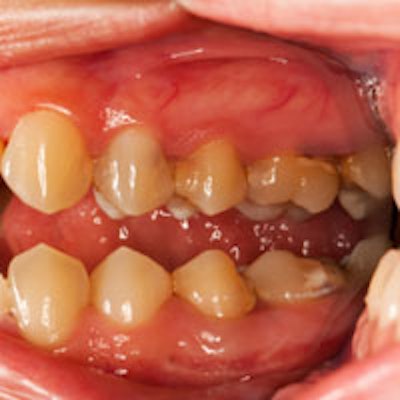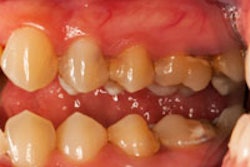
There is a high level of periodontitis among U.S. adults age 30 and older, especially among the Hispanic population, according to a new study by the U.S. Centers for Disease Control and Prevention (CDC). Some 65 million adults (about 46% of the U.S. adult population) had periodontitis during the years 2009 to 2012.
The study, published in the Journal of Periodontology, also revealed that half (50%) of Asian American adults had the disease (May 2015, Vol. 86:5, pp. 611-622). The study data come from the 2009 to 2010 and 2011 to 2012 cycles of the National Health and Nutrition Examination Survey (NHANES).
 Capt. Bruce Dye, DDS, MPH, dental epidemiology officer, NIDCR. Image courtesy of the NIDCR.
Capt. Bruce Dye, DDS, MPH, dental epidemiology officer, NIDCR. Image courtesy of the NIDCR."We've known for some time that two ethnic groups, Hispanics and non-Hispanic blacks, are at high risk for periodontal disease," Capt. Bruce Dye, DDS, MPH, dental epidemiology officer with the National Institute of Dental and Craniofacial Research (NIDCR), told DrBicuspid.com. "Many factors are at play. There could be cultural factors; they could include diet, smoking, and alcohol use. We know smoking is a major promoter of periodontal disease and that may be a very important driver of the differences."
Dentists who treat Hispanic, black, and Asian patients should encourage them not to use tobacco products and limit their alcohol consumption, according to the report.
For adults age 30 and older, the researchers found that 46% of U.S. adults had periodontitis, about the same rate (45.1%) as a similar study from the 2001-2004 NHANES. Periodontitis prevalence was associated with increasing age and was higher among males (55% for males, 37% for females).
In adults older than age 65, the periodontitis rate increased to 68%. The report also found disparities in the prevalence of the disease (see chart below).
| Periodontitis rates | |
| Population | Prevalence by percentage |
| People with less than a high school education | 67.0 |
| Current smokers | 66.6 |
| Hispanics | 63.5 |
| People living below the federal poverty level | 62.2 |
| Non-Hispanic blacks | 59.1 |
| Asian-Americans | 50.0 |
| Non-Hispanic whites | 40.8 |
Among the 46% of adults who had periodontitis, 9% had a more severe form. About 88% had attachment loss at a minimum of 3 mm, and 42% had a probing depth of at least 4 mm at one or more sites.
About 42% of adults had a probing depth of 4 mm or greater at one or more sites (see chart below).
| Highest prevalence of 4 mm or greater probing depths | |
| Population | Prevalence by percentage |
| Current smokers | 63.1 |
| Hispanic population | 62.7 |
| Adults living below 100% of poverty level | 59 |
The highest prevalence of the most severe probing depth, 7 mm or greater, was found in Hispanics (11.9%) and current smokers (6.8%). The mean probing depth for the total adult population examined was 1.61 mm in the years 2009 to 2012. About 5% of non-Hispanic Asian-Americans had a probing depth of at least 7 mm.
Notably, the U.S. estimates appear to be much lower than those reported from certain European populations. For example, a study that included 3,255 people in Germany ages 20 to 70 years found 20% with severe periodontitis (versus 9% in the U.S. 2009-2012) and 35.3% (versus 30.9% U.S.) with moderate periodontitis, leaving less than half (44.7%) of the population with only mild or no periodontitis (J Periodontol, March 2014, Vol. 41:3, pp. 224-231).
“Smoking has really significant detrimental effects on gingival health and on the bone that helps support teeth.”
Dr. Dye surmised that higher periodontitis rates in Germany are caused by more people smoking in that country.
"A lot is related to tobacco use," he said. "We don't see it across all the European groups. Smoking prevalence is higher in Germany than in the U.S."
Antismoking campaigns in the U.S. have been more successful than other countries, Dr. Dye noted
"One of the things that's interesting is that smoking is declining in the U.S. at a faster rate than other Western countries," he said. "Age distribution is also a factor, especially when you look at severe periodontal disease. We have a younger population in the U.S., and a lot of older Europeans smoke."
Materials and methods
The analysis used data from 7,066 adults (3,515 males, 3,551 females; ages 30 to 80 with a mean age of 51) who participated in the NHANES of the U.S. civilian noninstitutionalized population.
Periodontitis was defined by combinations of clinical attachment loss (AL) and periodontal probing depth (PD) from six sites per tooth on all teeth, except third molars, using standard surveillance case definitions. The severity and extent of PD and AL used measurements from all six sites per tooth.
- Severe periodontitis: More than two interproximal sites with a minimum AL of 6 mm (not on the same tooth) and more than one interproximal site with a PD of 5 mm or greater.
- Moderate periodontitis: More than two interproximal sites with an AL at least 4 mm (not on the same tooth) or more than two interproximal sites with a PD more than 5 mm, also not on the same tooth.
- Mild periodontitis: At least two interproximal sites with a minimum AL of 3 mm and at least two interproximal sites with a PD of 4 mm or greater (not on the same tooth) or one site with a minimum PD of 5 mm.
Reducing disease
What can be done to improve the periodontal disease rate among adults?
Dr. Dye cited smoking and good oral hygiene as the prime factors to decrease periodontitis.
"If you use tobacco products, now is a great time to quit, especially for those who smoke cigarettes," he said. "Smoking has really significant detrimental effects on gingival health and on the bone that helps support teeth. If not the No. 1 cause of periodontal disease, smoking is among the top three causes."
Since more people are retaining their teeth, it's important to maintain good oral hygiene, Dr. Dye noted.
"We're entering a different age from our parents and grandparents, and we're retaining more of our teeth," he said. "And as we retain more teeth, we have more teeth that become susceptible to periodontal disease. So it makes it important for us to continually practice good oral hygiene throughout our life span. So brushing is really important and making sure that we maintain a healthy mouth."



















